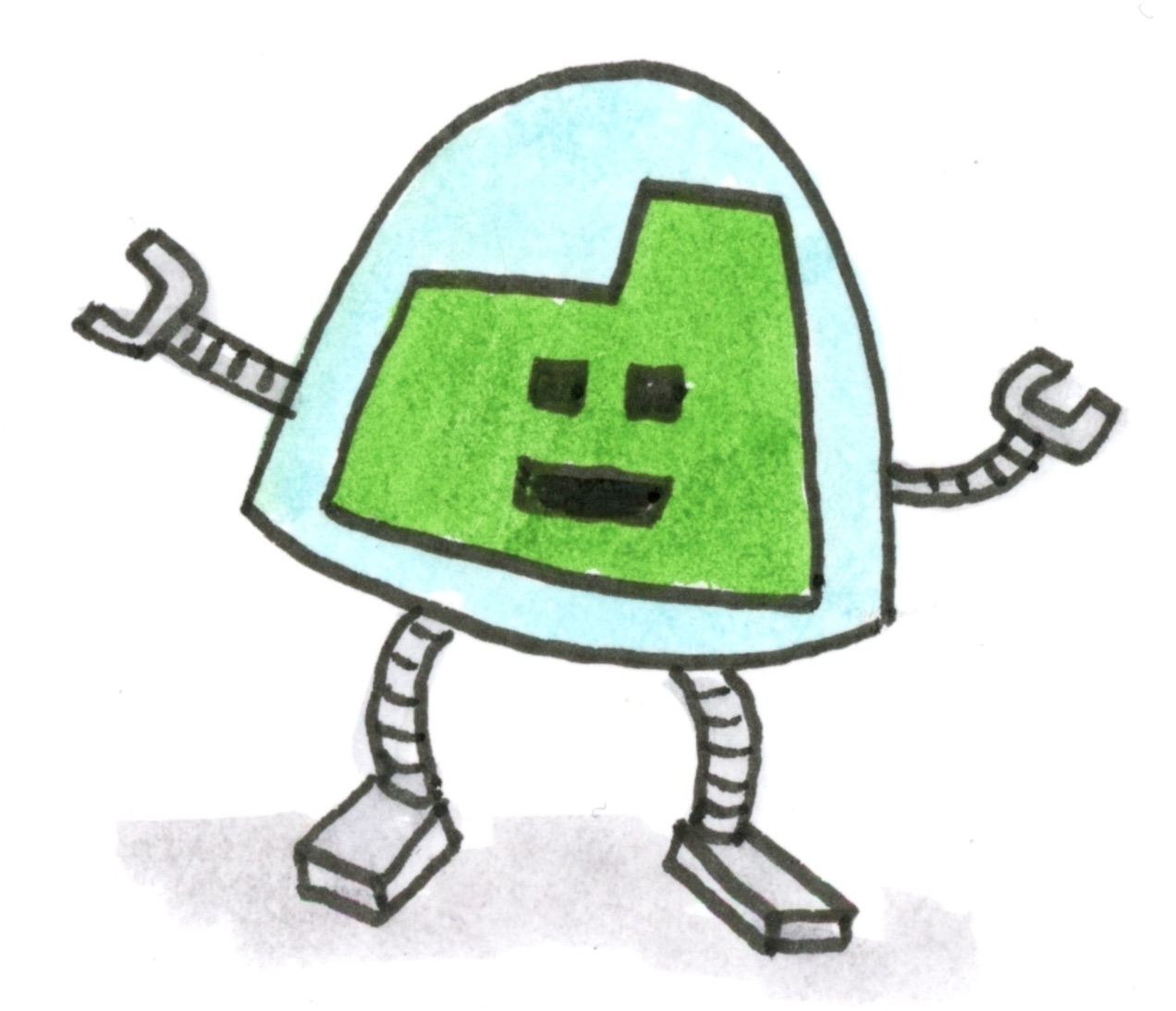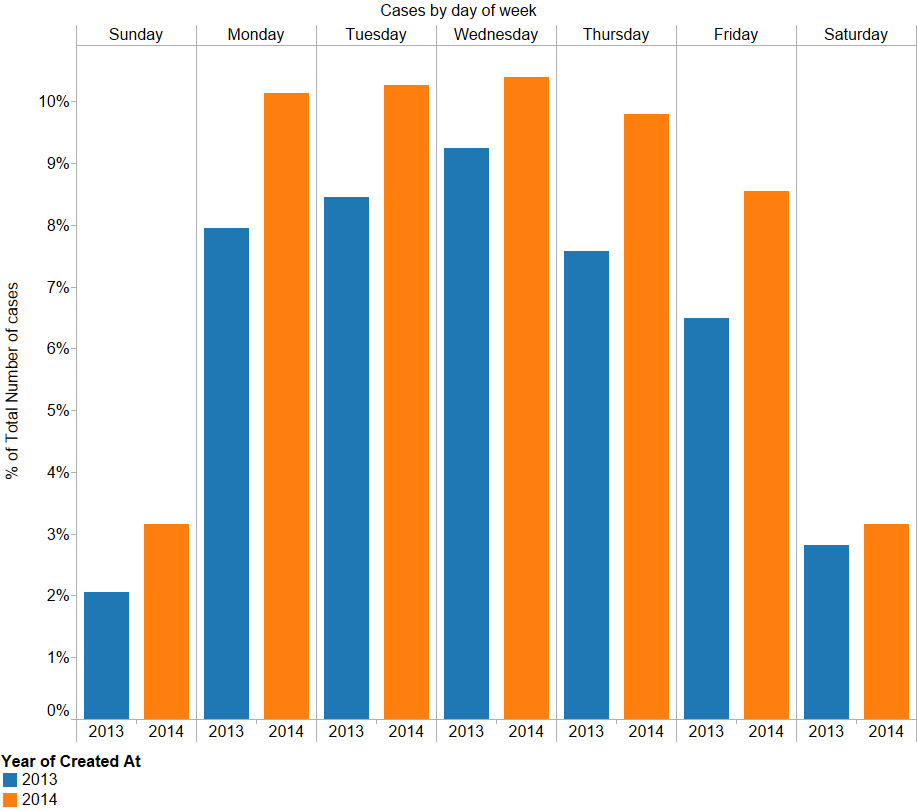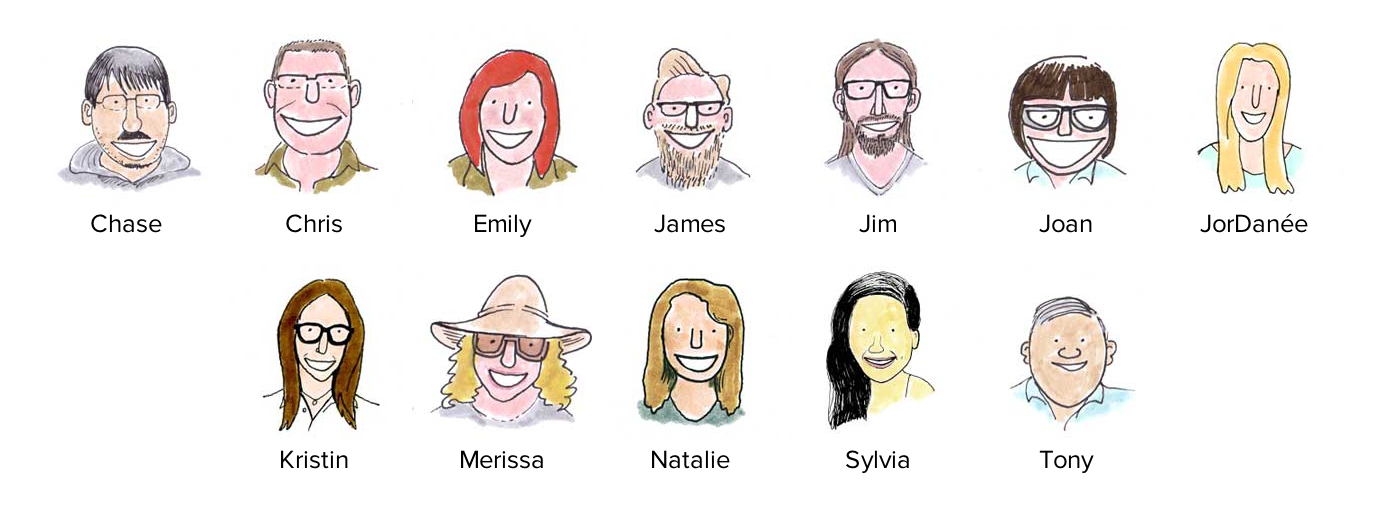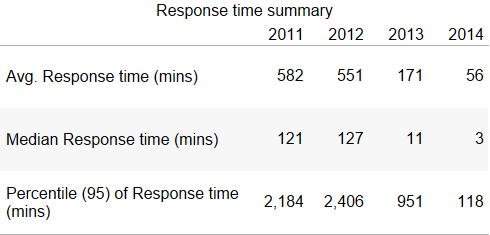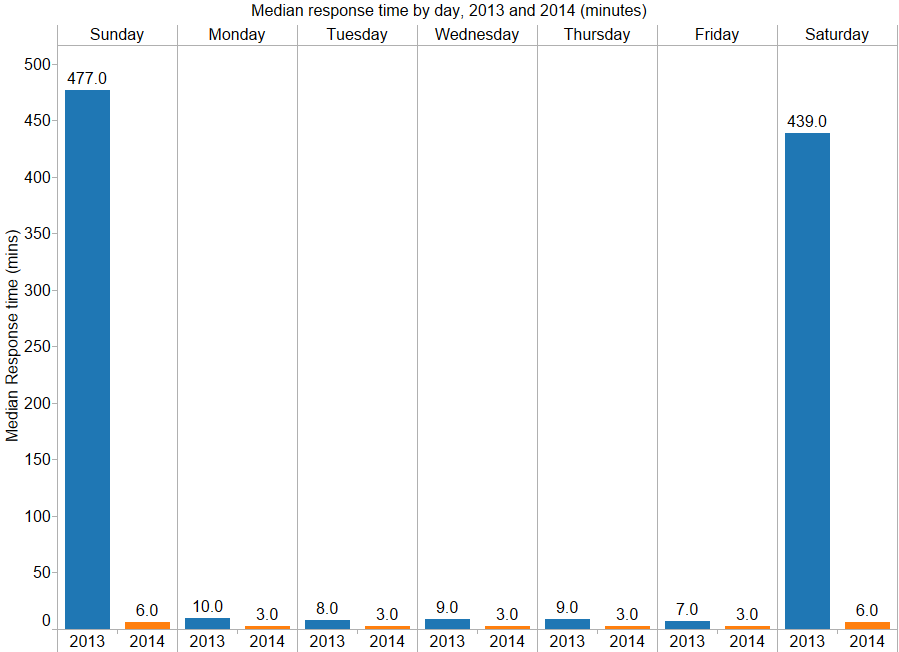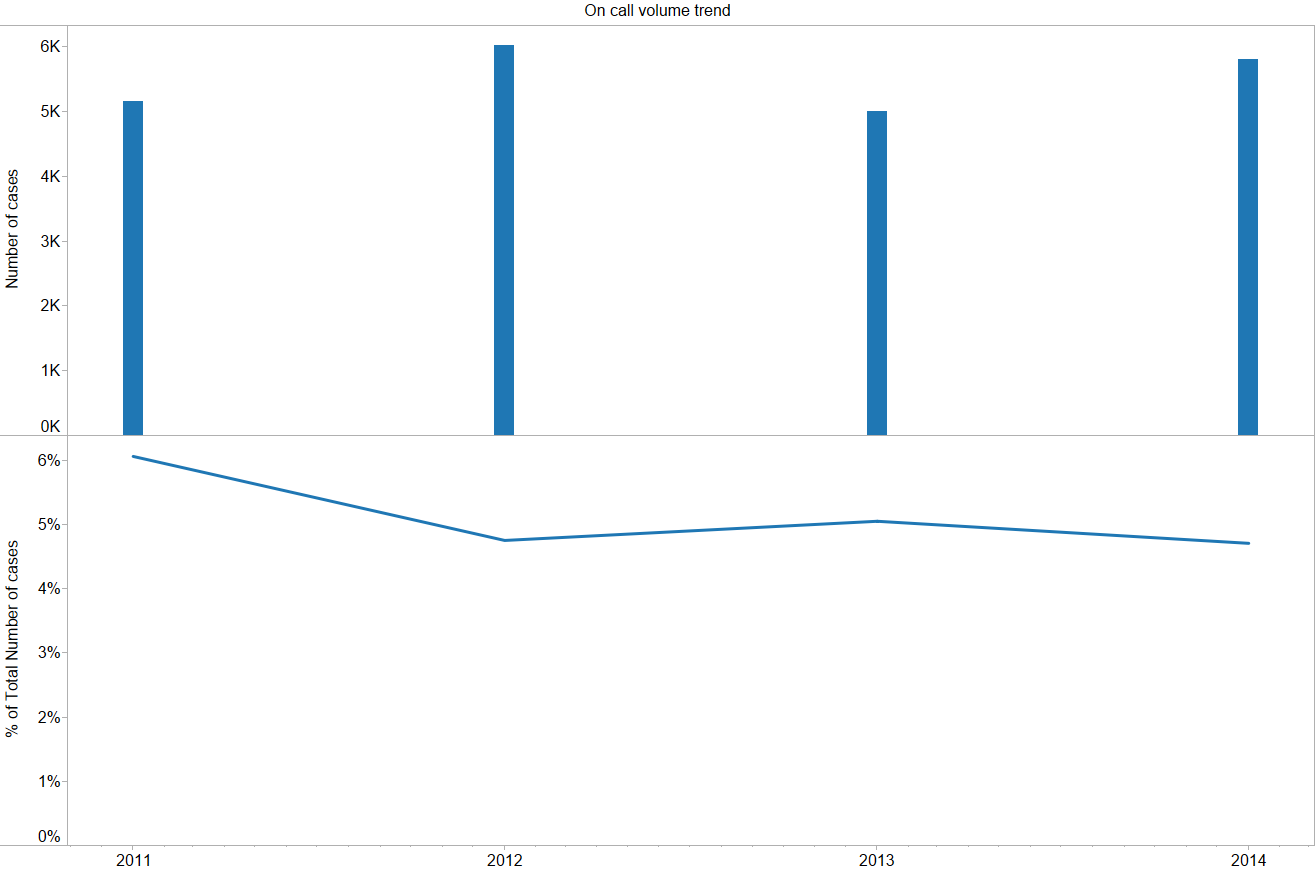Last year we topped 40 people at Basecamp. And that’s when I began to notice that we didn’t know as much about each other as we used to when we were smaller.
When any group gets to a certain size, it naturally begins to splinter into smaller groups. Cliques form and conversations often stay inside those cliques. That’s natural and OK, but I thought it would be nice to force some cross-clique personal conversations so everyone could get to know everyone else a little bit better again.
So I had this idea to bring together five random people (plus me and David) once a month for a one-hour free-flowing anything goes conversation, and then share the conversation with the rest of the company after it was over. The topics weren’t forced or pre-determined – whatever emerged was fair game. I’d sort of moderate the discussion to get it going, but after that whatever happened happened. The plan wasn’t to talk about work – it was to get a glimpse of what was going on in everyone’s lives outside of work. Could be exciting stuff, boring day-to-day stuff, whatever stuff. Life stuff.
We called it the 5×12. 5 people, 12 times a year. Andrea, our office manager, would select the people for each call, and the participants on the call would be kept secret until the call started. No one would know who was on this particular 5×12 call until each person popped into the conversation. A little surprise would help break the ice and just generally make things a little more interesting.
Since we’re a majority-remote company, we’d hold these monthly 5×12 video sessions using Google Hangout. Only the people on the call would be in the Hangout, but Andrea would transcribe/interpret each call and then post that transcript to Basecamp a couple days later so everyone in the company could read it. This way the actual call would remain intimate, but the stories would be shared company-wide.
I wasn’t sure how it would go – it was just an experiment. We’ve done six of them so far and I think they’ve been a big success. We continue to do them today (in fact today is the seventh one). We all get to learn a bit more about each other every month, and everyone looks forward to reading Andrea’s often humorous take on the conversation.
If you’re finding that you’re not as in tune with the people you work with as you once were, I’d recommend giving the 5×12 idea a try. I think it’s especially important for remote teams. I definitely feel like we’re all a little closer than we were before.
I thought it would be nice to share one of the transcripts from the 5×12 calls so you can get a sense of how these go and the sorts of things that came up in conversation.
What follows is the transcript from the very first call back in July, 2014. Enjoy!
TRANSCRIPT
Partipants: Jason, DHH, Mig, Ann, John, Natalie, and Javan.
Ann asked about the metal chotchke in the team room. JF said Ben is researching BC stickers, and one idea was a metal emblem. He’s getting samples from people who do metal work, and that was one example, but it is too ornate. He’s also getting some other samples in wood and other materials.
John talked about moving to Indy. He lived there for 4 years during college, now back in the suburbs which is weird, little but of an adjustment living in a subdivision, and not where i saw himself living, but it’s okay. Jason asked how they decided to move. JW said the choice was between living close to Marie’s parents in Indy or JW’s parents in the middle of nowhere, so they chose Indy. They were in a motorhome for awhile, the idea was to keep traveling, “then Marie got pregnant, and living in a confined space with a pregnant wife is not the best option”. (<—quote) They still have the motorhome in storage and camp on a regular basis, just not going all the time. John bought the motorhome new, and there’s a warranty, but still tons of bugs to be worked out. The guy who sold it to them said “you’re putting a house on wheels with a big engine, things are going to break”.
DHH tries to get American motorhomes in Europe, because the European versions are shitty: “Americans know how to put a house on wheels”. At Le Mans, one of the racers asked about a hotel room, and his team got him a motorhome instead. It was a European “shed on wheels”.
Mig drew a mustache on DHH, and DHH danced like a mariachi and then stroked his chin, like an old timey train robber.
NK has been camping a lot this summer and went to Norway a few weeks ago, near the Arctic Circle to camp on an island for 9 days. She just signed a lease on a new apartment which has an office. Some questions from the group about the Arctic Circle — NK says she went to the highest area in Norway and camped, it was cold but not unbearable — 8 Celsius, and midnight sun. Sun didn’t set the whole time they were there.
Mig put a Cat In The Hat hat on DHH. Unclear if he noticed.
JF wants to see the Northern Lights one day (and space shuttle launch). AG saw the Lights in Door County when she was a kid and it terrified her.
Someone drew a monocle on John.
John and family are planning on going to Cape Canaveral to see a SpaceX launch. He doesn’t know which viewing areas are open to the public, but they’re just going to go and figure it out.
Mig & Javan had a weekend in Michigan “Basecamp boys weekend” for 4th of July with Michael and Trevor. JM showed them around, really fun, hung out in nature. Then they checked out Detroit and 1/2 were scared shitless. AG asked which half, and Mig admitted it was actually all of them. Every building was dilapidated, but then they ran into pockets of cool places and shops, followed by other scary pockets where you shouldn’t walk. DHH wondered how dangerous Detroit is. He said it’s funny how you get perception of an area – before the World Cup, you’d hear how Brazil is dangerous, and then you see the stats for Chicago (37 shootings in one weekend), and it’s interesting how relative “danger” is.
MR also saw Javan’s new car – MR knows a lot about cars, and described it as blue, shiny, vintage, well kept, “dreamy”, very nice. He shared the Instagram pics, and the guys looked like they’re in a boy band. DHH commented that there was not enough duck face.
Javan actually knows something about cars (not really) and described his new car: 1970 BMW 2002, 44 years old. He bought it on eBay, which was a weird experience. He never saw the car, he bought it from someone in Delaware. He took a blind leap and clicked “bid” and won. Two days later it showed up on a truck at his house, very bizarre, impulse buy on something that could be totally fucked up when it shows up. He’s been driving it more than he’s supposed to. It’s registered as a collectors car, legally supposed to drive it to only car shows and club trade events, but he’s been driving it on errands. It’s been raining a ton, and he can’t get the car wet because it leaks and will rust, so it’s been in the garage lately.
JF asked Javan: why did you buy it? JM used to have a 1979 Saab he bought for $1000, not a fancy car but he loved it. Every single thing was mechanical, everything was solid, nothing broke because it was just metal. He got rid of it 5 years ago and was missing it. This winter was cold and boring, so he looked at fun cars and fell in love with this one. Old cars are romantic, they’re pleasing in a way that new cars aren’t, and they have character that new cars don’t have. Maybe some new small batch nice cars, but the factory mass produced cars today won’t age with the same character as old cars.
JF said old cars make people feel good. People smile and ask about them. He asked if Javan finds that true? Javan said that in Michigan, the car stands out a little more, there aren’t many cars like it on the road. “Lots of cheers & fist pumping when I drive by.” Lots of old timers want to know a lot about it, and young kids just want him to rev the engine and drive fast. The factory stats say the car does 0-60mph in 12.9 seconds, so it’s probably even slower now. JF’s dad has an early 1980s model car, and there are alway people telling him about it when he drives around.
Mig moved into a new apartment. He’s not been home much, but loves the place. He can see the sunset with west-facing windows. It’s his first time living alone and first time in a loft style place, and it’s great. It’s close to nice places in the neighborhood & transit, close to the office, but still in a separate neighborhood away from work. He’s having a fun summer, going on weird weekend camping trips. He is glad to go out and do things, but also thinking more about being home and enjoying alone time. He lived with roommates since leaving high school, so it took him a few weeks to realize no one was going to come home, which was weird at first. Mig wears pants “most of the time”. The building has a cool roof deck and MR meets new people every time he goes up there – likes talking to different people of all different walks of life. He gets the feeling of living mates, but no one bothers him.
JF asked if anyone wanted to talk about work stuff.
Javan has been working with Sam for 3-4 months on Trix. It’s been super fun, and it’s the first time he’s worked with another programmer closely. Usually, everyone works in a team with others, but it’s rare for 2 programmers to work together, and it’s been fun. “Sam is obviously the smartest person in the world”, and Javan has learned a lot working with him. Javan says it would be cool to do more projects like that. He does not know if designers or other people feel the same way, but JM things programmers don’t get enough opportunity to work together. A lot of that is the nature of the projects, but it would be nice to do more often. JF: we’ve been pretty optimized for efficiency, which doesn’t lend itself to the same groups of people working together. As a company, we’re trying to do too many things at once — last cycle, we had 8 projects running concurrently. When you have that many projects and a product team and only 15-16 people, it’s not possible for a lot of people to work together. Moving forward, we want to have fewer projects and more people on those projects. Not 8—8 means most people are working independently. DHH: And it’s not even efficient. It has a veneer of efficiency, but there are all these other coordinations costs. This cycle we did some things that weren’t of the highest priority because we had the people. We want to have slightly larger teams doing fewer things in serial, rather than small teams working in parallel. It’s also hard for JF & DHH to be involved with 8 concurrent things. And fewer projects means everyone is pulling in the same direction. JF has been working closely with Scott and Conor, and that pairing is going well.
Someone asked DHH if the math formulas on the blackboard in the storage room is real? When we first moved into the office, JF tweeted, asking someone to come put “a bunch of math” on the chalkboard for the hell of it. A mathematician from U of C agreed, and he “put a bunch of shit on the board”. He said it was real, but we’ve never checked. There are a few eraser marks from the guy who did it, so we think they’re actually real bc he screwed up as he was writing it.
Mig talked about being paired with Julia this summer. It’s cool to have an intern and fun to see someone wide-eyed about things that he thinks are basic. She gives a different perspective when working on The Distance, and she’s so curious. It’s fun to slow yourself down to teach someone else. A challenge, but fun. Hopefully she’ll be able to hang out with everyone and work on some other stuff. She wants to work on everything. She’s working on some postcards. Mig gave her general creative direction, but told her to “make it something you’re proud of, it’s going in the real world and that doesn’t happen at a lot of internships, so run with it”. MR is very impressed with her work and ambition. George is killing it, too. MR is happy we’re taking on “green talent”.
JF was in a room with Julia & Mig, and they talked about art school. In school, they never make anything for real clients, make budgets, they never send things to press/do press checks – all that real life stuff doesn’t happen in school, and it should.
Mig does portfolio reviews a lot, and it’s disheartening to see so much fake work that never goes into production. MR wants to help educate students by using real projects because “that’s weird that school doesn’t do that for designers”. School opens the doors to design work, but he did’t really learn anything in school. Half the people at Basecamp learned on their own, no formal school, so going to school a gamble. Students think “an adulthood switch flips” and you have a job, but design school doesn’t really prep you for real work. They sell you on a dream job, but then the industry is saturated with unprepared people.
DHH: Denmark pays you to go to school for 6 years, and you’d think that would change the culture. You’d think everyone would take a graduate degree, but the rates of graduation aren’t very different than the US. It does change the makeup of students and degrees—which in the US seems to be changing too. Students in the US go into tens of thousands of dollars in debt, and the end degree is not something you would buy for that amount of money. MR: art school costs over $100k, and there’s no education about education.
JW: also, whenever people talk about student loan debt, they call it “good debt”, that’s the sales bit. DHH said, but it’s actually the worst – there’s high interest rates, and you can’t clear it in bankruptcy. JW agrees, but mentions that they say it’s worth the interest, but what they don’t tell you is that you’ll be writing checks for the next 15 years. DHH the market makes no sense – people tend have a native instinct of small items being too expensive (e.g. a hot dog should not be $5, it should be $2), but people don’t have the same sense about large-scale items like education. JF says people who pay for their own education seem to have a better sense of the cost. If you’re paying out of pocket with no loans, you are more realistic. The loan makes you feel like it’s not your money. People who pay out of pocket get the same level of education, but when you get a loan at 18 years old, you don’t know the consequences of debt like that.
AG got rid of her car, rides her bike everywhere now, and she gets rained on all the time. She doesn’t even think about the rain anymore – about 5 years ago, she just accepted it. DHH said, in the US, being a “bicycle person” is part of your identity, and in Denmark, it’s just what everyone does. Two months ago, he was home and noticed that literally everyone bikes, people in suits, in long dresses. In California, the only people on bikes have a full spandex suit. In Denmark, people bike to go places. JF: do people who own cars in Denmark have car culture? Since it’s a smaller segment of the population, in the way that there’s a bike culture here? DHH said no, you’d think the minority would have an allegiance to each other, but they don’t. Javan: how do people bike in suits and then go to work? Don’t people sweat? DHH said they just don’t bike that fast, and it’s cooler there. People are more leisurely. Another funny difference – in Chicago, everything has air conditioning. Nowhere in Copenhagen has AC. If it’s really hot one day, that’s just the temperature. Natalie says it’s the same in Berlin, no AC, “and I sweat when I ride my bike”. AG also sweats. Mig is Filipino, which means he does not sweat but glows. DHH said there’s always a difference in cultural comfort zones. It’s hard to even imagine something outside of that comfort zone, like not having AC when it’s hot. But people are so adaptable. Few people in Denmark care about biking/sweating, or thinking about AC when it’s hot. The drawback of amenities is that we’re continuously shrinking our comfort zones. JF said DHH should start the trend in Chicago and get rid of his AC and car. DHH agreed (no he didn’t).
John bikes in Indy. There are no hills, cornfields, flat as a pancake, so he rides around in big squares. He rides on the outside of town, low traffic. DHH saw study on the safety of helmets. Motorists who see bikers with helmets tend to drive closer to the bike than they would if the biker did not have a helmet. Same principle as another study about mountain roads. On mountain road turns with guard rails, the accidents/fatalites shot way up – people drive as fast as they want because of the illusion of safety. Where there are no guard rails, people were more careful. In some ways, it’s “unsafer to be safe.” It’s perverse that the behavior that protects you in an accident potentially gets you into the accident in the first place. Illinois state law says there should be 3 feet distance between driver and cycle. Indiana has weird laws – bikers have to have a bell on your bicycle. JW has no bell. He stares down cops when he rides by, like a young James Dean.
Natalie said that she and James are starting European-based classes for Support, next Friday. They aren’t changing the class, but the time zone will cover a lot more people. AG asked if she is using the metric system (no). DHH hears all the time from people about Support classes – they love it, and he feels like the classes have a positive affect on retention. NK is learning German using Rosetta Stone and it’s going well. She’s hoping to be more fluent in 6 months because she has her visa renewal in 6 months and needs to be “more German” by then. NK is already German in that she uses walking sticks, has tall socks, and “a version of lederhosen”. She also likes pretzels. She is not German in that she has not had cheeseburger in a can.
NK loves Rosetta Stone. If you’re speaking incorrectly, it’ll tell you right away. Some other programs, as long as you talk at all, it’s tell you you’re right. She also took group classes in person, and Rosetta Stone is better. DHH said, admiringly: “robots, man.” DHH’s wife is using Rosetta Stone for Spanish, and she prefers it even above a tutor. Her tutor’s pace was too slow, and Rosetta allows you to go at your own pace, review things. NK said you can also “make a fool of yourself to yourself” and it doesn’t matter, and there are no distractions from other students. This goes back to the value of education – a lot of people can probably learn better from cheaper classes online, robots, software. Robots, man, indeed.
DHH brought up the book on introversion (Susan Cain’s “Quiet”). Three-quarters of the population are extroverts, and the education system is built around them. The rest of the population probably learn better on their own, they find focus in isolation, so the move towards online distance learning is better for introverts.
THE END.



